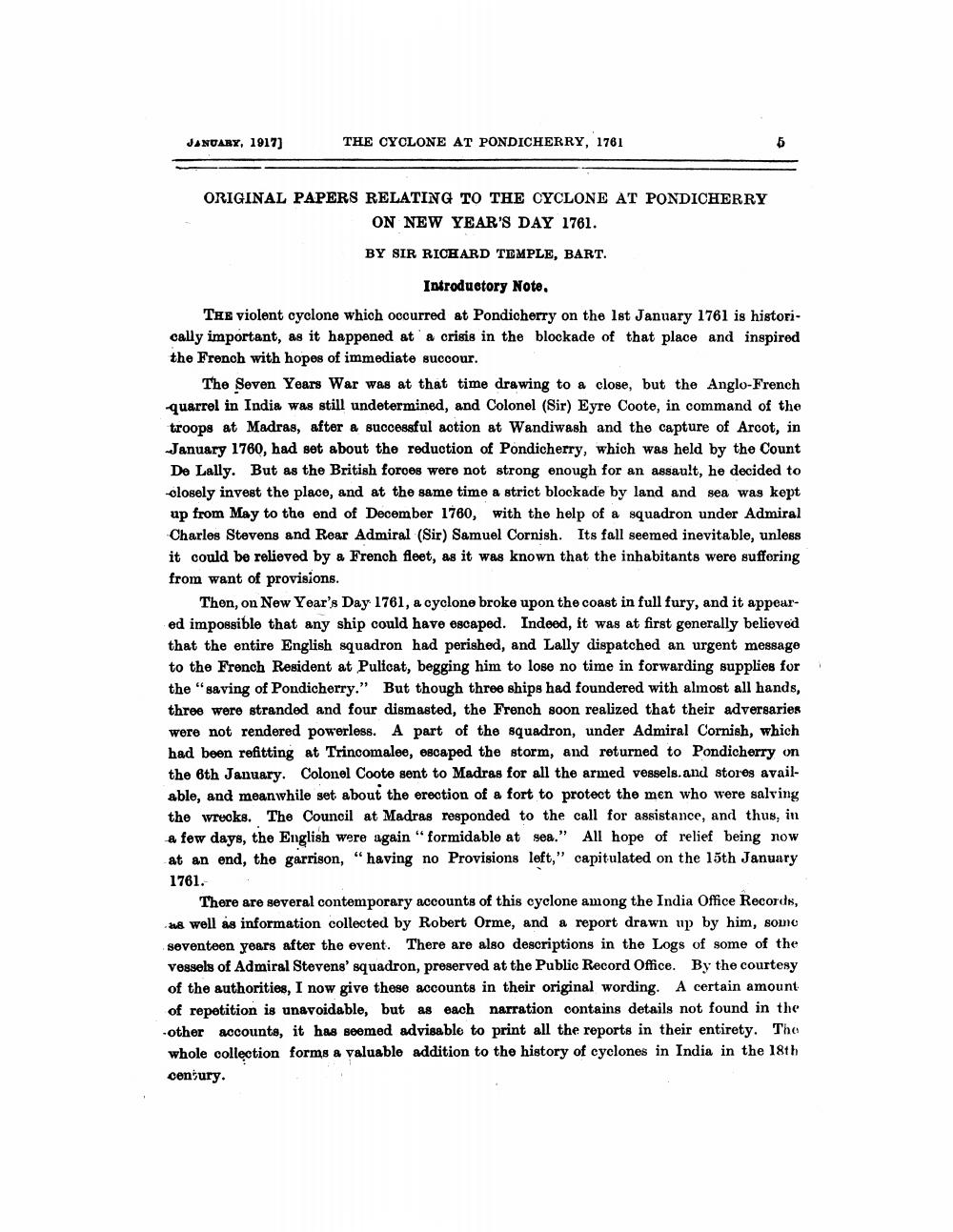Book Title: Indian Antiquary Vol 46 Author(s): Richard Carnac Temple, Devadatta Ramkrishna Bhandarkar Publisher: Swati Publications View full book textPage 9
________________ JANUARY, 1917) THE CYCLONE AT PONDICHERRY, 1761 ORIGINAL PAPERS RELATING TO THE CYCLONE AT PONDICHERRY ON NEW YEAR'S DAY 1761. BY SIR RICHARD TEMPLE, BART. Introductory Note. The violent cyclone which occurred at Pondicherry on the 1st January 1761 is historically important, as it happened at a crisis in the blockade of that place and inspired the French with hopes of immediate succour. The Seven Years War was at that time drawing to a close, but the Anglo-French quarrel in India was still undetermined, and Colonel (Sir) Eyre Coote, in command of the troops at Madras, after a successful action at Wandiwash and the capture of Arcot, in January 1760, had set about the reduction of Pondicherry, which was held by the Count De Lally. But as the British foroos were not strong enough for an assault, he decided to closely invest the place, and at the same time a strict blockade by land and sea was kept up from May to the end of December 1760, with the help of a squadron under Admiral Charles Stevens and Rear Admiral (Sir) Samuel Cornish. Its fall seemed inevitable, unless it could be relieved by a French fleet, as it was known that the inhabitants were suffering from want of provisions. Then, on New Year's Day 1761, a cyclone broke upon the coast in full fury, and it appeared impossible that any ship could have escaped. Indeed, it was at first generally believed that the entire English squadron had perished, and Lally dispatched an urgent message to the French Resident at Pulicat, begging him to lose no time in forwarding supplies for the "saving of Pondicherry." But though three ships had foundered with almost all hands, three were stranded and four dismasted, the French soon realized that their adversaries were not rendered powerless. A part of the squadron, under Admiral Cornish, which had been refitting at Trincomalee, escaped the storm, and returned to Pondicherry on the 6th January. Colonel Coote sent to Madras for all the armed vessels and stores available, and meanwhile get about the erection of a fort to protect the men who were salving the wrecks. The Council at Madras responded to the call for assistance, and thus, in a few days, the English were again formidable at sea." All hope of relief being now at an end, the garrison, "having no Provisions left," capitulated on the 15th January 1761. There are several contemporary accounts of this cyclone among the India Office Records, 28 well as information collected by Robert Orme, and a report drawn up by him, somo seventeen years after the event. There are also descriptions in the Logs of some of the Vessels of Admiral Stevens' squadron, preserved at the Public Record Office. By the courtesy of the authorities, I now give these accounts in their original wording. A certain amount of repetition is unavoidable, but as each narration contains details not found in the -other accounts, it has seemed advisable to print all the reports in their entirety. The whole collection forms a valuable addition to the history of cyclones in India in the 18th century.Page Navigation
1 ... 7 8 9 10 11 12 13 14 15 16 17 18 19 20 21 22 23 24 25 26 27 28 29 30 31 32 33 34 35 36 37 38 39 40 41 42 43 44 45 46 47 48 49 50 51 52 53 54 55 56 57 58 59 60 61 62 63 64 65 66 67 68 69 70 71 72 73 74 75 76 77 78 79 80 81 82 83 84 85 86 87 88 89 90 91 92 ... 508
